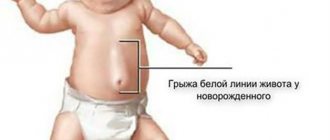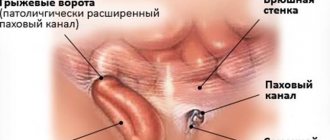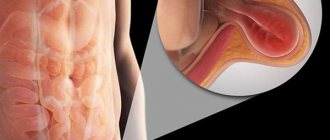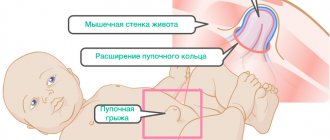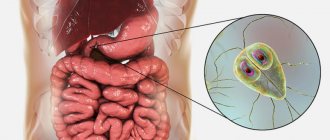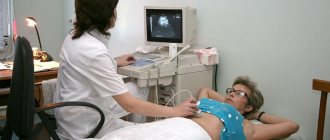Causes of pain in the navel area
Intestinal dyspepsia
Pain occurs when there are errors in the diet (the predominance of fatty, heavy foods), after heavy feasts with alcohol, under the influence of stress factors.
The pain syndrome is inconsistent and has moderate intensity. Patients describe their sensations as aching, pulling, stabbing. Pain in the navel area intensifies after eating, accompanied by heaviness and rumbling in the abdomen, diarrhea. Pain syndrome is characteristic of dyspepsia caused by food allergies. In this case, a feeling of discomfort in the navel area develops 1-2 hours after consuming a certain product. With severe sensitization of the body to the allergen, pain appears immediately after finishing the meal. Then nausea, vomiting, and diarrhea occur with the release of liquid stool of normal color.
Enzyme deficiency
Disorders of digestion (maldigestion) and absorption (malabsorption) of food in the small intestine are one of the most common causes of pain in the navel. Patients complain of constant discomfort, which intensifies 30-40 minutes after finishing a meal. Features of symptoms are determined by the type of enzyme deficiency:
- Lactase deficiency.
Pain syndrome is provoked by the intake of milk or dairy products containing lactose. There is moderate pain in the navel area, which is accompanied by rumbling in the abdomen and flatulence. The pain decreases slightly after defecation, during which liquid, foamy stool with a sour odor is released. - Exocrine pancreatic insufficiency.
Discomfort and pain do not depend on the composition of the food taken. I am worried about constant nagging pain in the abdominal cavity, which is localized near the navel, in the epigastrium and in the area of the left hypochondrium. The pain syndrome is combined with steatorrhea, creatorrhea, and lienterea.
Food poisoning
Unpleasant sensations develop in the peri-umbilical region due to food toxic infections, intestinal infections that occur as gastroenteritis, enterocolitis. Typical for poisoning are cramping pains near the navel, which appear suddenly and have varying intensity. They begin a few hours after eating low-quality foods or drinking water from unknown sources.
The symptom most often occurs with salmonellosis, for which the “triangle” is pathognomonic - pain in the epigastrium, around the navel and in the ileocecal zone. When pressing on the navel, a person feels sharp pain. Pain syndrome is also possible with other intestinal infections (escherichiosis, rotavirus gastroenteritis, yersiniosis). It is accompanied by repeated vomiting and diarrhea, dehydration.
Chronic enteritis
With chronic enteritis, minor pain and discomfort are constantly observed in the area surrounding the navel. Exacerbation of pain occurs under the influence of food and other provoking factors. The pain intensifies immediately after finishing eating, at the same time the urge to defecate appears. After the passage of gas and bowel movements, the pain subsides.
Pain in the navel area
Pathologies of the gastroduodenal region
With diseases of the stomach and duodenum, pain occurs not only in the epigastric region, but also around the navel. Severe hunger or night pain, relieved after eating, are characteristic of ulcers of the antrum and duodenal ulcers. With pyloric stenosis, complaints are made of bursting and dull pain, which subside after vomiting, but do not completely disappear. An attack of sharp pain in the epigastric and navel areas may be associated with volvulus or acute dilatation of the stomach.
Pancreatitis
Chronic pancreatitis is characterized by constant, low-intensity pain to the left of the navel, aggravated by eating large amounts of fatty and carbohydrate-rich foods. The symptom is accompanied by diarrhea; the stool contains pieces of undigested food. In acute pancreatitis, the patient experiences sharp girdling pain, affecting the peri-umbilical region and upper abdomen.
Umbilical hernia
In the initial stages of the disease, slight discomfort is felt near the navel, which intensifies when this area is compressed by tight clothing or a belt. As the hernia increases in size, a constant dull pain appears. A painless protrusion is formed in the area of the umbilical ring, which is easily reduced into the abdominal cavity. The complicated course of the hernia is indicated by severe pain attacks localized around the navel.
Diverticulosis
With inflammation of the diverticula of the small intestine, stabbing, aching, sharp pains around the navel develop. The sensations do not have a direct connection with meals, but can intensify after a heavy feast, when an increased load on the intestines is created. The pain syndrome is complemented by chronic diarrhea, which occurs 3-5 times a day and alternates with periods of normal stool.
Small bowel obstruction
Against the background of complete well-being, cramping pain occurs in the navel area. Its intensity periodically increases, which corresponds to the passage of a peristaltic wave. An early sign is vomiting of gastric contents, which after some time becomes fecal in nature. After 24-36 hours, the intensity of pain decreases, which serves as a prognostically unfavorable sign. A similar clinical picture is also typical for intestinal volvulus.
Appendicitis
In the first 2-3 hours of acute appendicitis, pain is felt near the navel. They have a cramping character, which does not change after changing body position or defecation. After the onset of pain, vomiting occurs once or twice. After a couple of hours, the pain shifts to the right iliac region. They are accompanied by weakness, pale skin, and increased body temperature.
Whipple's disease
Whipple's disease is characterized by paroxysmal pain around the navel, which occurs suddenly and is not associated with dietary factors. At the same time, diarrhea develops up to 10 times a day, nausea and vomiting. There is severe flatulence with colic-like or bursting pain in the center and sides of the abdomen. The pain syndrome is accompanied by arthralgia, febrile fever, and swollen lymph nodes.
Malignant tumors
Neoplasms of the small intestine manifest as pain in the navel area or to the left of it. The pain syndrome bothers the patient for several months, its intensity gradually increases. Over time, the umbilical pain becomes unbearable and standard painkillers do not respond to it. Malignant neoplasia is characterized by stool disorders, sudden weight loss, and signs of protein-energy deficiency.
Rare causes
- Pathologies of the urinary system
: horseshoe kidney, urachus cyst. - Vascular damage
: atherosclerosis of the abdominal aorta, mesenteric ischemia. - Hernias
: linea alba, Spigelian line.
Non-surgical causes
Diseases that do not require surgical intervention can also be divided into 2 large groups:
- infectious;
- non-infectious.
- Allergic reaction. Infants may suffer from it after the introduction of their first complementary foods;
- Infection with helminths. Personal hygiene rules are not always observed for children, which can lead to helminthic infestation;
- Colic. This problem is typical for newborn babies and can be solved at home. It is better to consult a doctor in advance about what to do in such cases;
- Infectious lesions of the genitourinary system. If your stomach constantly hurts, but everything is fine with your digestive system, you should check the genitourinary system. This problem often occurs in preschool children;
- Dysbacteriosis. This is a process that is not dangerous in itself, but it can cause more complex and serious diseases, so it is important to start treatment on time;
- Biliary dyskinesia;
- The beginning of menstruation is in girls.
Intestinal infections cause abdominal pain, accompanied by diarrhea, vomiting and fever. There are symptoms of intoxication. It is not always possible to independently distinguish a mild infection from acute appendicitis, which is why a child with abdominal pain should always be examined by a specialist. Non-infectious causes include:
Diagnostics
During a physical examination, a gastroenterologist performs superficial and deep palpation, assesses areas of greatest pain, and pays attention to signs of impaired nutritional status. To identify the causes of pain in the navel area, laboratory and instrumental studies are prescribed. The diagnostic plan includes:
- Radiography
. Plain radiography of the abdominal cavity is informative for detecting signs of small bowel obstruction. X-ray examination with oral contrast is necessary to find ulcerative defects and diverticula. The technique provides an assessment of intestinal motor function. - Ultrasound diagnostics
. Ultrasound of the abdominal organs is a non-invasive way to visualize the anatomical and physiological features of the gastrointestinal tract. Using sonography, the doctor identifies signs of inflammatory damage to the pancreas, stomach or intestines. Duplex scanning is effective for assessing the condition of the abdominal aorta. - Endoscopic techniques
. The most informative method for examining the small intestine is video capsule endoscopy. It allows you to evaluate the structure of the mucosa, identify erosive and ulcerative defects, detect bulk neoplasms and signs of metaplasia. If the gastroduodenal area is affected, EGD is indicated. - Additional instrumental methods
. When large intestinal tumors are found, a CT or MRI must be performed to clarify their structure and the degree of involvement of surrounding tissues. Electrointestinography is indicated to determine intestinal motor activity. - Stool tests
. To evaluate the activity of digestive enzymes, a coprogram is used. Signs of pathology are the presence of striated muscle fibers, neutral fats, and starch grains. Intestinal inflammation is indicated by the content of mucus and leukocytes in the stool. If an intestinal infection is suspected, stool culture is recommended.
Pain in the navel area 1
Treatment
Help before diagnosis
Functional dyspeptic disorders can be successfully corrected by changing diet and lifestyle. If pain at the navel is combined with loose stools, you need to temporarily eliminate dairy products, fatty foods, and dishes with artificial sweeteners. The diet should consist of grain crops, stewed or boiled vegetables, lean meat and fish in moderation. It is important to avoid stressful activities.
If there are signs of food poisoning, first aid includes gastric lavage, if you have recently consumed low-quality food, and taking sorbents. It is necessary to drink more liquid (water, unsweetened dried fruit compote) to prevent dehydration of the body. With severe umbilical spasms and a sharp deterioration in health, the patient needs emergency medical care.
Conservative therapy
The treatment regimen is selected after identifying the root cause of peri-umbilical pain syndrome. Treatment is mainly carried out on an outpatient basis. Hospitalization is required for exacerbation of a chronic disease, a possible acute surgical condition, or severe dehydration. In gastroenterology, the following groups of drugs are used for pain in the peri-umbilical region:
- Enzymes
. Preparations of pancreatic enzymes improve digestion processes, eliminate the phenomena of malabsorption, due to which the pain syndrome disappears. For some combined pathologies of the intestines and stomach, in addition to enzymes, gastric juice is recommended. - Antispasmodics
. Most episodes of pain in the navel area are associated with spastic contractions of the intestines, which are successfully relieved by drugs with antispasmodic effects. For severe pain, analgesics are taken. - Probiotics
. Medicines normalize intestinal microflora and prevent bacterial overgrowth syndrome (SIBO). They are effective for a combination of pain and dyspeptic symptoms. To enhance the effect of probiotics, they are supplemented with prebiotics. - Antidiarrheal drugs
. For chronic diarrhea that is not corrected with diet, medications of the loperamide group are prescribed. They normalize gastrointestinal motility, slow down the movement of feces, and eliminate excessive peristaltic contractions and associated pain in the abdominal area.
The doctor selects a balanced diet that must be followed to prevent exacerbations of the disease. During the period of remission of chronic diseases, drinking mineral waters, physiotherapy methods, and sanatorium-resort treatment are recommended. In case of severe functional disorders of the gastrointestinal tract, it is advisable to conduct psychotherapy, which is aimed at eliminating the effects of stress factors.
Surgery
Pain in the navel area can be caused by surgical pathologies (appendicitis, intestinal obstruction), for which urgent surgical treatment is indicated. For uncomplicated forms of diseases in abdominal surgery, laparoscopic surgical techniques are used. Small intestinal obstruction and destructive forms of appendicitis require open surgery by laparotomy.
For hernias, various methods of hernioplasty are performed using mesh allografts and the patient’s own tissue to close the umbilical ring defect. Treatment of oncological processes involves an extended operation with resection of a section of the intestine and surrounding tissues as a single block, after which an intestinal anastomosis is formed or an enterostomy is removed.
Popular questions and answers
We discussed common questions about lower abdominal pain in men with urologist Rodion Vasilevsky .
When to see a doctor if a man has pain in his lower abdomen?
Any pain cannot be tolerated for long, otherwise a persistent chronic pain syndrome will form, which will be extremely difficult to cope with with usual measures.
You need to see a doctor immediately! You should seek medical help as soon as possible if: ● the pain continues to get worse; ● high temperature appeared; ● noticeable blood in the stool (fresh or black and foul-smelling); ● inability to walk due to pain; ● periodic vomiting appears, especially if there is blood in the vomit.
Is it possible to treat lower abdominal pain in men with folk remedies?
Since the causes of pain and the mechanisms of their occurrence are complex and variable, I do not recommend self-medication using folk remedies. Be sure to consult a doctor!
